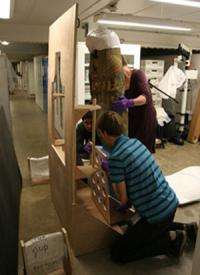Ancient Egyptian mummy saved by engineering and LEGO

Thanks to an ambitious conservation project and some tiny pieces of plastic, the ancient Egyptian mummy case of Hor is now on display in the Fitzwilliam Museum, Cambridge.
The conservation of the cartonnage mummy case was undertaken with the assistance of the Department of Engineering, who helped construct clever frames to support the delicate case during conservation and a new display case with internal supports using LEGO.
The mummy case was found in the Ramesseum at Thebes in 1896. The gilded wooden face had been torn out by robbers and the mummy removed. Cartonnage is a uniquely Egyptian material, often only a few millimetres thick, consisting of layers of plaster, linen and glue. It is remarkably rigid but also very sensitive to humidity. At some point Hor had been exposed to damp conditions and had sagged dramatically around the chest and face. This caused structural problems and also serious cracking and instability in the painted decoration. There had been some attempts at repair and restoration, most probably in the cartonnage's early years in the Museum.
In the recent project, the conservators wanted to reshape the cartonnage by using humidity to soften it and allow it to be manipulated. But introducing water into this material was risky because the painted surface is very easily damaged by moisture, and furthermore, if the whole cartonnage were softened at once there was a real danger it would collapse. Introducing water in a controlled way to the distorted area could only really be done if the cartonnage was face-down - but the fragile state of the chest and face made this almost impossible.
Luckily, help was available from the Department of Engineering at the University of Cambridge. In the latest of a series of collaborations with the Museum's conservators, the Department offered the problem as a project for a final year student. The challenge was taken up by David Knowles. In close consultation with the Fitzwilliam, David devised and made a frame to suspend Hor face-down while the reshaping was carried out. Using a combination of traditional wooden frames and mouldable materials designed for medical use, Hor could be completely supported for weeks at a time, allowing conservator Sophie Rowe to reshape the cartonnage very gradually.
Once Sophie had successfully reshaped the chest and face and stabilised the surface, David designed and built a display mount for the mummy case. An essential part of this is the internal support which ensures that the structure cannot collapse again in the future. Six light, ingenious little structures made from LEGO have been placed inside the chest cavity. They are adjustable using screw threads, and are padded with archival foam where they are in contact with the ancient surface.
A great result for Hor, who can now be displayed safely and for David, who was awarded a prize by the Department of Engineering for his final presentation on the project.
An Anglia Television newscast of the project can be viewed here.
Provided by University of Cambridge



















